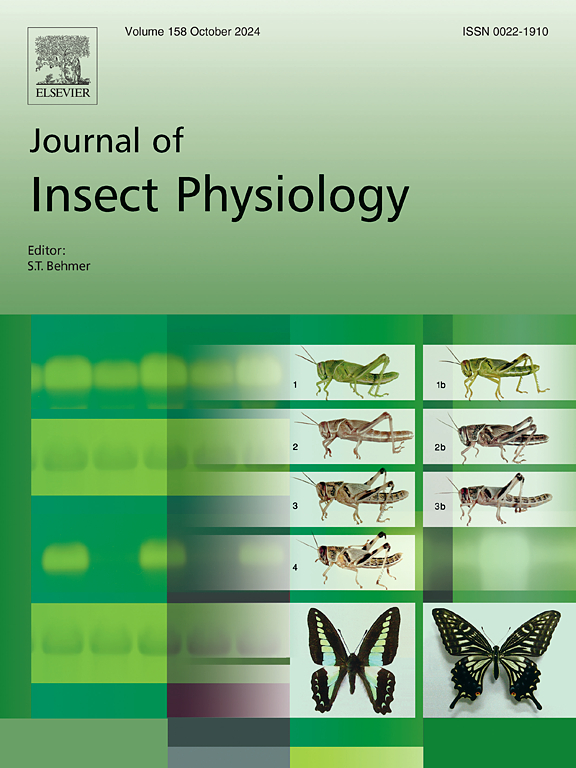白蚁蚁后的生理和相关机制塑造了高的终身繁殖力。
IF 2.3
2区 农林科学
Q1 ENTOMOLOGY
引用次数: 0
摘要
白蚁是群居昆虫,蚁群通常由一对繁殖蚁(蚁后和蚁王)领导。在这对皇室夫妇的一生中,他们的生育能力会随着年龄的增长而增加。在女王身上,它反映了卵巢不成比例的发育和腹部角质层的扩大,这种现象被称为生理发育。除了对卵巢和卵子生产的影响外,生理上的改变还需要其他系统如消化系统、气管系统、肌肉系统和循环系统的形态和生理上的改变,这一过程需要数年才能完成。考虑到采样困难和在一些模式物种中没有胃皇后,这样的话题被忽视了,迄今为止还没有提供全面的审查。在此,我们旨在回顾白蚁蚁后的生理过程,从这一过程中形态学变化的先驱研究到成熟蚁后繁殖力和长寿的分子机制的最新进展(如TI-J-LiFe框架)。驱动这一现象的内在和外在因素,其对菌落生长的影响,以及目前的知识差距也进行了讨论。我们期望我们的方法为白蚁生理学的进一步研究铺平道路,特别是考虑到分子工具的进步和最近的白蚁系统发育,以及与其他群居昆虫的比较分析和不同群体中驱动这种现象的机制。生理反应在成年昆虫中是一种罕见的过程,在白蚁蚁后中尤为显著,它提供了一个独特的机会来揭示一个高度多产的生命的基础。本文章由计算机程序翻译,如有差异,请以英文原文为准。

Termite queen physogastry and associated mechanisms shaping a high lifetime fecundity
Termites are eusocial insects whose colonies are usually headed by a pair of reproductives (queen and king). During its lifespan, the royal couple faces an age-dependent increase in fecundity. In queens, it reflects on the disproportional development of the ovaries and enlargement of the abdominal cuticle, a phenomenon referred to as physogastry. Beyond the impact on the ovaries and egg production, physogastry requires the morphological and physiological reprogramming of other systems such as the digestive, tracheal, muscular, and circulatory, resulting in a process that takes years to happen. Given the sampling difficulty and the absence of physogastric queens in some model species, such a topic is overlooked, and a comprehensive review has not been provided to date. Here we aim to review the process of physogastry in termite queens, from the pioneer studies on the morphological changes accompanying this process to recent advances in the molecular mechanisms underlying fecundity and the remarkable longevity reached by mature queens (e.g., TI-J-LiFe framework). Intrinsic and extrinsic factors driving this phenomenon, its impact on colony growth, and the current knowledge gaps are also discussed. We expect that our approach paves the way for further studies of termite physogastry, especially given the advances of molecular tools and recent termite phylogenies, and comparative analyses with other eusocial insects and the mechanisms driving this phenomenon in the different groups. Physogastry is a rare process in adult insects and remarkable in termite queens, offering a unique opportunity to unravel the basis of a highly fecund life.
求助全文
通过发布文献求助,成功后即可免费获取论文全文。
去求助
来源期刊

Journal of insect physiology
生物-昆虫学
CiteScore
4.50
自引率
4.50%
发文量
77
审稿时长
57 days
期刊介绍:
All aspects of insect physiology are published in this journal which will also accept papers on the physiology of other arthropods, if the referees consider the work to be of general interest. The coverage includes endocrinology (in relation to moulting, reproduction and metabolism), pheromones, neurobiology (cellular, integrative and developmental), physiological pharmacology, nutrition (food selection, digestion and absorption), homeostasis, excretion, reproduction and behaviour. Papers covering functional genomics and molecular approaches to physiological problems will also be included. Communications on structure and applied entomology can be published if the subject matter has an explicit bearing on the physiology of arthropods. Review articles and novel method papers are also welcomed.
 求助内容:
求助内容: 应助结果提醒方式:
应助结果提醒方式:


